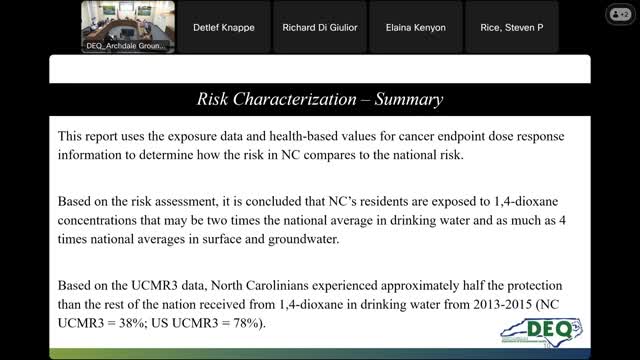North Carolina report reveals dioxane levels threaten drinking water safety in Cape Fear River Basin
December 04, 2024 | Environmental Quality, Cabinet Departments, Organizations, Executive, North Carolina
This article was created by AI summarizing key points discussed. AI makes mistakes, so for full details and context, please refer to the video of the full meeting. Please report any errors so we can fix them. Report an error »

Concerns over cancer risk from drinking water contaminants dominated the North Carolina Department of Environmental Quality's Science Advisory Board meeting on December 4, 2024. Board members scrutinized a recent report that failed to calculate individual cancer risks for residents exposed to various levels of contaminants, particularly 1,4-dioxane.
During the meeting, it was revealed that while the report highlighted a high number of people exposed to these contaminants, it did not provide a maximum risk assessment for the population. One board member questioned whether the report met the legislative request for comprehensive risk calculations, to which officials confirmed that the scope was aligned with the legislative inquiry. They emphasized that the report utilized a margin of exposure calculation, which they believed was more relevant for the audience.
A significant point of discussion was the margin of exposure for North Carolinians, which was found to be approximately half that of the national average. This raised alarms about the level of protection residents have against potential health risks. The board clarified that a larger margin of exposure indicates greater protection, and the phrasing in the report may have caused confusion regarding the actual risk levels.
The meeting also addressed the impact of regulatory policies on environmental occurrences of contaminants. Data presented indicated a reduction in environmental occurrences since 2022, attributed to these policies. However, concerns were raised about specific regions where 1,4-dioxane levels remained high, suggesting that regulatory efforts had not sufficiently mitigated risks in those areas.
Board members expressed the need for a more granular analysis of water quality by watershed, arguing that statewide assessments could obscure the challenges faced by communities in heavily impacted areas, such as the Cape Fear River Basin. They urged for a breakdown of data that would better reflect the varying levels of protection across different regions.
As the meeting concluded, the board underscored the importance of clear communication regarding water safety and the need for ongoing assessment and regulatory action to protect public health in North Carolina.
During the meeting, it was revealed that while the report highlighted a high number of people exposed to these contaminants, it did not provide a maximum risk assessment for the population. One board member questioned whether the report met the legislative request for comprehensive risk calculations, to which officials confirmed that the scope was aligned with the legislative inquiry. They emphasized that the report utilized a margin of exposure calculation, which they believed was more relevant for the audience.
A significant point of discussion was the margin of exposure for North Carolinians, which was found to be approximately half that of the national average. This raised alarms about the level of protection residents have against potential health risks. The board clarified that a larger margin of exposure indicates greater protection, and the phrasing in the report may have caused confusion regarding the actual risk levels.
The meeting also addressed the impact of regulatory policies on environmental occurrences of contaminants. Data presented indicated a reduction in environmental occurrences since 2022, attributed to these policies. However, concerns were raised about specific regions where 1,4-dioxane levels remained high, suggesting that regulatory efforts had not sufficiently mitigated risks in those areas.
Board members expressed the need for a more granular analysis of water quality by watershed, arguing that statewide assessments could obscure the challenges faced by communities in heavily impacted areas, such as the Cape Fear River Basin. They urged for a breakdown of data that would better reflect the varying levels of protection across different regions.
As the meeting concluded, the board underscored the importance of clear communication regarding water safety and the need for ongoing assessment and regulatory action to protect public health in North Carolina.
View full meeting
This article is based on a recent meeting—watch the full video and explore the complete transcript for deeper insights into the discussion.
View full meeting
